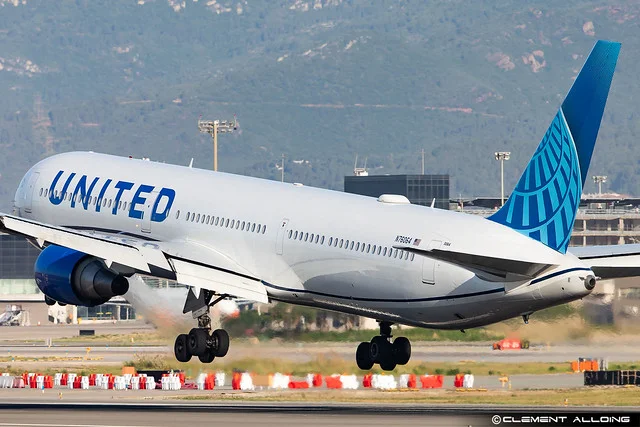A Routine Flight Turns Into a Critical Emergency
On May 27, 2025, United Airlines Flight UA770 was operating a routine long-haul journey from Barcelona El Prat Airport (BCN) to Chicago O’Hare International Airport (ORD). The aircraft, a Boeing 787-9 Dreamliner, with registration N26902, had safely departed at its scheduled time and climbed into cruising altitude over Western Europe.
Roughly 1 hour and 30 minutes into the flight, however, an unexpected issue occurred on board, prompting the flight crew to declare a general emergency by broadcasting Squawk 7700—the universal transponder code signaling distress. As a result, the aircraft was swiftly rerouted and diverted to London HeathrowAirport, where it landed safely with all passengers and crew unharmed.
What Does “Squawk 7700” Mean?
When an aircraft squawks 7700, it is declaring a serious emergency to Air Traffic Control (ATC). This code instantly alerts nearby ATC facilities and airports that the aircraft requires immediate attention and priority landing clearance.
Common reasons for squawking 7700 include:
- Mechanical or system failure
- Loss of cabin pressurization
- Engine malfunction
- Smoke or fire detection
- Onboard medical emergencies
Why Was London Heathrow Chosen for Diversion?
Diverting a transatlantic flight is not a random choice it involves careful calculation. The decision to reroute UA770 to London Heathrow was likely due to a combination of factors:
- Proximity to current flight path
- World-class emergency infrastructure
- Availability of long runways suitable for a 787-9
- Experienced ground emergency and maintenance teams
London Heathrow, as one of the busiest and best-equipped airports in Europe, was an ideal diversion point to handle such a situation without delay.
The Landing: Calm, Controlled, and Safe
Upon receiving clearance, UA770 was guided into a controlled descent into Heathrow’s airspace. Emergency services including firefighters, paramedics, and airport response teams were dispatched immediately and waited on standby. The aircraft landed safely on Runway 27R, then taxied to Gate B44 without further incident.
No injuries or damage were reported, and passengers were safely disembarked. United Airlines personnel were present to assist with rebooking, accommodations, and support services for the delayed passengers.
How Aviation Safety Protocols Averted Disaster
This incident is a textbook example of how modern aviation safety systems are designed not only to detect issues quickly but to prevent a potentially catastrophic event from ever occurring.
Here’s how the system worked effectively:
- Pilot Decision-Making: The cockpit crew’s swift choice to declare an emergency and divert ensured that they remained within safe reach of emergency landing options.
- Aircraft Systems: Onboard diagnostics helped detect the anomaly early possibly a fault in hydraulics, engine systems, or pressurization.
- Air Traffic Control (ATC): Coordinated a safe, clear path to Heathrow with priority airspace clearance.
- Emergency Services: Mobilized even before landing, ensuring immediate medical and technical support.
- Crew Training: Flight attendants kept passengers calm and informed, reducing panic and facilitating smooth evacuation.
Without these protocols, a delayed response or continued flight over the Atlantic could have significantly increased risk especially if a technical failure escalated beyond control. This case reminds us that aviation safety is not reactive it’s preventive.
The Human Impact: Inside the Cabin
While passengers were understandably anxious, multiple sources confirm that the cabin crew remained calm and composed, making regular announcements and instructing passengers on emergency preparations.
One passenger shared via social media that the crew’s professionalism kept the cabin from panicking. “We were scared for a moment, but the flight attendants were incredibly clear and calm. That made all the difference,” the passenger said.
Investigation and What Comes Next
As per standard post-incident procedures, United Airlines and aviation safety authorities (likely the FAA and UK Civil Aviation Authority) will conduct a full investigation into the incident.
Steps include:
- Downloading and analyzing black box data (Flight Data Recorder and Cockpit Voice Recorder)
- Aircraft inspection and fault diagnosis
- Pilot and crew debriefs
- Maintenance history review
A Wider Look: The Aviation Industry’s Role in Crisis Prevention
Incidents like UA770 don’t just demonstrate emergency response they affirm that the aviation sector is one of the safest industries globally. Each flight, aircraft, and crew operates under layers of safety systems, making aviation one of the best-defended forms of public transportation.
Some key safety pillars include:
- Pilot training and simulation-based emergency drills
- Aircraft redundancy systems (multiple backups for engines, pressure, and hydraulics)
- Global air traffic control coordination
- Strict aircraft maintenance and certification standards
- Real-time tracking and telemetry alerts
Final Thoughts
United Airlines Flight UA770’s emergency diversion was a moment of high tension but it ended as a story of success. The aircraft landed safely. The situation was contained, controlled, and professionally handled from takeoff to touchdown.
This was not just a lucky outcome it was the result of decades of investment in aviation safety, constant training, and a no-compromise approach to protecting passengers. While emergencies can never be entirely eliminated, this incident proves that we are safer than ever in the skies.







